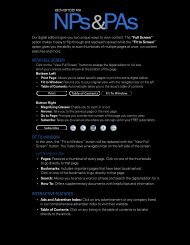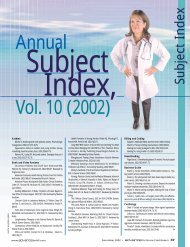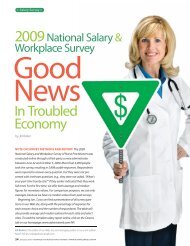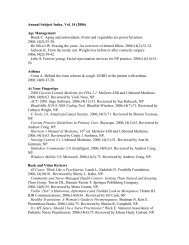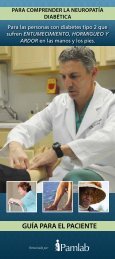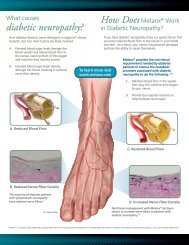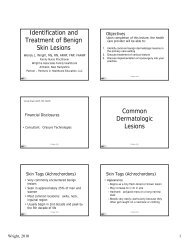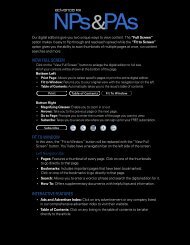Download - ADVANCE for NPs & PAs
Download - ADVANCE for NPs & PAs
Download - ADVANCE for NPs & PAs
- No tags were found...
You also want an ePaper? Increase the reach of your titles
YUMPU automatically turns print PDFs into web optimized ePapers that Google loves.
CME/CE: DiabetesT2DM will meet glycemic goals of A 1cbelow 7%. 5,13 Meanwhile, only 26% ofpeople in the United States with diagnoseddiabetes (both types) use insulin. 1That number is quite low consideringthe number of people with T2DM. Theresponsibility <strong>for</strong> delays in insulin initiationrests with both healthcare providersand patients.Table 1Summary of Glycemic Recommendations <strong>for</strong>Adults With Diabetes 3Glycemic ValueA 1c < 7%Preprandial glucosePostprandial glucoseRecommended Result70 mg/dL to 130 mg/dL< 180 mg/dLBarriers to Starting InsulinMany clinicians delay the intensificationof diabetes management due to lack ofsufficient knowledge about insulin agentsand how to individualize therapy <strong>for</strong> eachpatient. 8,14 Many new types of insulin analogsare now available, and choosing thecorrect insulin regimen can be daunting.Another issue is finding sufficient time toinitiate insulin within the context of a primarycare visit. Primary care offices arenot always staffed to provide the patienteducation that is required, and findingappropriate referral services, such as acertified diabetes educator or registereddietitian, can be difficult. 15-17Another common barrier that canresult in clinical inertia is assuming thatthe patient will be resistant or may feeltoo overwhelmed to initiate insulin.Consequently, the discussion about theneed <strong>for</strong> insulin does not occur and thepatient’s hyperglycemia goes unchecked. 18Too many providers regard insulin as atreatment of last resort. Other providerconcerns include the erroneous beliefthat insulin increases cardiovascularrisks and fears about hypoglycemia andweight gain. 19 Consequently, providersmiss the opportunities to start insulineven when A 1c approaches 9% or riseseven higher. As noted by the UKPDSstudy, earlier initiation of insulin is necessaryto prevent long-term complicationsbecause it inhibits glucotoxicity and mayhelp preserve beta cell mass. 9Some patients are hesitant to start insulin.Fear of needles, weight gain and hypoglycemiaare commonly cited, and manypatients believe that insulin therapy is a signof personal failure or that they are disappointingtheir healthcare providers andfamilies. 8 Some patients may mistakenlyassociate insulin with late development ofcomplications such as dialysis, amputations,or even death. Healthcare providersneed to point out that starting insulinwill help prevent the poor outcomes thatoccur when hyperglycemia is inadequatelymanaged. 18,20When to Start InsulinMost experts agree that therapy shouldbe intensified when one or more oralagents fail to maintain A 1c below 6.5%to 7%. Most oral agents lower A 1c by 1%to 1.5%, so when the level is above 8.5%and the patient is already taking severaloral agents, it is time to consider insulin.Insulin also is a recommended option <strong>for</strong>the patient who has not yet started oraltherapy but has an A 1c of 8.5% or greater.Insulin should be started in every patientwhose A 1c is greater than 10%. 12,16,21-23The goal of insulin is to mimic the body’sphysiologic pulsatile release of insulin.Normally, basal insulin is released insmall amounts to suppress catabolism ofmuscle and fat to help regulate hepaticproduction of glucose. Beta cells alsosecrete insulin to manage carbohydrateconsumption and avoid postprandialhyperglycemia. In the presence of food,insulin is normally secreted in two phases.The first is to cover hepatic productionof glucose and the second is to stimulateperipheral glucose uptake. Mostpeople with T2DM lack the first-phaseresponse, so exogenous insulin is neededto simulate this normal physiologicJane Kapustin is an adult nurse practitioner who is board certified in advanced diabetesmanagement. She is the assistant dean <strong>for</strong> the master’s and DNP programs at the Universityof Maryland School of Nursing in Baltimore and maintains a faculty practice at the Universityof Maryland Medical Center <strong>for</strong> Diabetes and Endocrinology. She has completed a disclosurestatement and reports no relationships related to this article.basal–bolus secretion. 5,8 Insulin levelsmust be precisely controlled to maintaineuglycemia and prevent hypoglycemia. 9,14The glycemic targets <strong>for</strong> A 1c , fasting andpostprandial blood glucose levels arelisted in Table 1.The new insulin analogs (rapid and longacting)more closely match the normalphysiologic release of endogenous insulin.Because they provide higher serum levelsof insulin earlier and have a shorter durationof action than older types of insulin,the rapid-acting analogs — lispro, aspartand glulisine — provide more flexibility<strong>for</strong> patients around mealtimes. 5 Additionaladvantages include the ability to reduceunchecked postprandial glucose excursionsand to reduce the risk of severe hypoglycemia.9 See Table 2 <strong>for</strong> more details.How to Start InsulinThe ideal regimen of insulin is the basal–bolus method because it provides thebest physiologic action and best glycemiccontrol. 4,5,8 But many patients are reluctantto adopt a complicated routine in aninitial attempt, so introducing a simplerroutine may be preferable. Choice ofinsulin and regimen is influenced bymany factors, including the patient’swillingness to inject more than once aday, his or her ability to manage insulininjections (including vision issues), theability to titrate and calculate doses, andcoordination with the patient’s lifestyle. 14Other factors to consider include patientage, work environment, cost and insurancecoverage, cultural influences, andcomorbidities. All of these factors influencethe decision to use basal insulinonce daily, premixed insulin or prandialcoverage added to basal insulin. 12,16,19It is important to note that glycemiccontrol does not need to occur immediately.In fact, it is best to titrate slowly toavoid patient dissatisfaction and danger-22 <strong>ADVANCE</strong> <strong>for</strong> <strong>NPs</strong> & <strong>PAs</strong>



